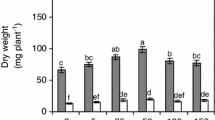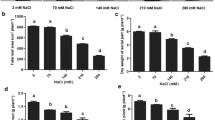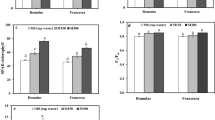Abstract
Salinity tolerance of sugar beet (Beta vulgaris L.) cultivars in terms of growth, proline and soluble sugars concentrations, and Na+/K+ and Na+/Ca2+ ratios were analyzed in this study. Three-week-old seedlings of three sugar beet cultivars, ‘Gantang7’, ‘SD13829’, and ‘ST21916’, differing in salinity tolerance, were treated with 0, 50, 100, and 200 mM NaCl. Plant shoots and roots were harvested at 7 days after treatment and subjected to analysis. Low concentration of NaCl (50 mM) enhanced fresh and dry weights of shoot and root in ‘Gantang7’, whereas high one (200 mM) reduced growth in all cultivars and the less reduction was observed in ‘ST21916’. Shoot proline was strongly induced by salinity stress in both ‘Gantang7’ and ‘SD13829’, while it remained unchanged in ‘ST21916’. The addition of 50 mM NaCl significantly increased shoot soluble sugars concentrations in ‘Gantang7’ while it had no significant effects in the other two cultivars. ‘Gantang7’ also showed a higher level of root soluble sugars concentration as compared to the other two cultivars. At 50 mM NaCl, the lower shoot Na+ concentration, and the higher shoot K+ and root Ca2+ concentration in ‘Gantang7’ resulted in the lower shoot Na+/K+ and root Na+/Ca2+ ratio. However, ‘SD13829’ maintained a lower Na+/K+ ratio in both shoot and root when subjected to 200 mM NaCl treatment. According to comprehensive evaluation on salinity tolerance, it is clear that ‘Gantang7’ is more tolerant to salinity than the other two cultivars. Therefore, it is suggested that ‘Gantang7’ should be more suitable for cultivating in the arid and semi-arid irrigated regions.






Similar content being viewed by others
Abbreviations
- ANOVA:
-
Analysis of variance
- DW:
-
Dry weight
- FW:
-
Fresh weight
- WC:
-
Water content
- SA:
-
The capacity of selective absorption for Na+ over K+
- SE:
-
Standard error
- ST:
-
The capacity of selective transport for Na+ over K+
- Ψs :
-
Osmotic potential
References
Ali G, Srivastava PS, Iqbal M (1999) Proline accumulation, protein pattern and photosynthesis in Bacopa monnieri regenerants grown under NaCl stress. Biol Plant 42:89–95
Ashraf M, Fatima H (1995) Responses of some salt-tolerant and salt-sensitive lines of safflower (Carthamus tinctorius L.). Acta Physiol Plant 17:61–71
Ashraf M, Harris PJC (2004) Potential biochemical indicators of salinity tolerance in plants. Plant Sci 166:3–16
Bao AK, Guo ZG, Zhang HF, Wang SM (2009) A procedure for assessing the salt tolerance of Lucerne (Medicago sativa L.) cultivar seedlings by combining agronomic and physiological indicators. N Z J Agric Res 52:435–442
Bates LS, Waldren RP, Teare ID (1973) Rapid determination of free proline for water stress studies. Plant Soil 39:205–207
Bavei V, Shiran B, Arzani A (2011) Evaluation of salinity tolerance in sorghum (Sorghum bicolor L.) using ion accumulation, proline and peroxidase criteria. Plant Growth Regul 64:275–285
Chołuj D, Karwowska R, Ciszewska A, Jasińska M (2008) Influence of long-term drought stress on osmolyte accumulation in sugar beet (Beta vulgaris L.) plants. Acta Physiol Plant 30:679–0687
Farkhondeh R, Nabizadeh E, Jalilnezhad N (2012) Effect of salinity stress on proline content, membrane stability and water relations in two sugar beet cultivars. Int J Agric Sci 2(5):385–392
Flowers TJ (2004) Improving crop salt tolerance. J Exp Bot 55:307–319
Flowers TJ, Yeo AR (1988) Ion relation of salt tolerance. In: Baker DA, Hall JL (eds) Solute transport in plant cells and tissues. Longman Scientific and Technical, Harlow, pp 392–413
Flowers TJ, Troke PF, Yeo AR (1977) The mechanism of salt tolerance in halophytes. Annu Rev Plant Physiol 28:89–121
Flowers TJ, Koyama ML, Flowers SA, Sudhakar C, Singh KP, Yeo AR (2000) QTL: their place in engineering tolerance of rice to salinity. Environ Exp Bot 51:99–106
Ghoulam C, Fares K (2001) Effect of salinity on seed germination and early seedling growth of sugar beet (Beta vulgaris L.). Seed Sci Technol 29:357–364
Ghoulam C, Foursy A, Fares K (2002) Effects of salt stress on growth, inorganic ions and proline accumulation in relation to osmotic adjustment in five sugar beet cultivars. Environ Exp Bot 47:39–50
Ibrahim SM, Ibrahim HAK, Omer AM (2012) Comparative study of the effects of some organic extract on sugar beet yield under saline conditions. Aust J Basic Appl Sci 6:664–674
Jamil M, Lee DB, Jung KY, Ashraf M, Lee SC, Rha ES (2006) Effect of salt (NaCl) stress on germination and early seedling growth of four vegetables species. J Cent Eur Agric 2:273–282
Juan M, Rivero RM, Romero L, Ruiz JM (2005) Evaluation of some nutritional and biochemical indicators in selecting salt-resistant tomato cultivars. Environ Exp Bot 54:193–201
Kingsbury RW, Epstein E, Pearcy RW (1984) Physiological responses to salinity in selected lines of wheat. Plant Physiol 74:417–425
Kronzucker HJ, Britto DT (2011) Sodium transport in plants: a critical review. New Phytol 189:54–81
Lee G, Carrow RN, Duncan RR (2005) Criteria for assessing salinity tolerance of the halophytic turfgrass seashore paspalum. Crop Sci 45:251–258
Liu HL, Wang QQ, Yu MM, Zhang YY, Wu YB, Zhang HX (2008) Transgenic salt-tolerant sugar beet (Beta vulgaris L.) constitutively expressing an Arabidopsis thaliana vacuolar Na+/H+ antiporter gene, AtNHX3, accumulates more soluble sugar but less salt in storage roots. Plant Cell Environ 31:1325–1334
Ma Q, Yue LJ, Zhang JL, Wu GQ, Bao AK, Wang SM (2012) Sodium chloride improves the photosynthesis and water status in succulent xerophyte Zygophyllum xanthoxylum. Tree Physiol 32:4–13
Munns R, Tester M (2008) Mechanisms of salinity tolerance. Annu Rev Plant Biol 59:651–681
Murakeozy EP, Nagy Z, Duhaze C, Bouchereau A, Tuba Z (2003) Seasonal changes in the levels of compatible osmolytes in three halophytic species of inland saline vegetation in Hungary. J Plant Physiol 160:395–401
Niu X, Bressan RA, Hasegawa PM, Pardo JM (1995) Ion homeostasis in NaCl stress environments. Plant Physiol 109:735–742
Noble CL, Rogers ME (1992) Arguments for the use of physiological criteria for improving the salt tolerance in crops. Plant Soil 146:99–107
Omar SAS, Madouh T, El-Baglouri I, Al-Mussalem Z, Al-Telaihi H (1998) Land degradation factors arid irrigated areas: the case of Wafra in Kuwait. Land Degrad Dev 9:283–294
Panahi M, Ghaemi M, Mostafavi K (2013) Salt stress effects on germination and early seedling growth stages in different sugar beet (Beta vulgaris L.). Adv Crop Sci 13:51–57
Radić S, Štefanić PP, Lepeduš H, Roje V, Pevalek-Kozlina B (2013) Salt tolerance of Centaurea ragusina L. is associated with efficient osmotic adjustment and increased antioxidative capacity. Environ Exp Bot 87:39–48
Ramoliya PJ, Patel HM, Joshi JB, Pandey AN (2006) Effect of salinization of soil on growth and nutrient accumulation in seedlings of Prosopis cineraria. J Plant Nutr 29:283–303
Rout NP, Shaw BP (2001) Salt tolerance in aquatic macrophytes: ionic relation and interaction. Biol Plant 44:95–99
Rozema J, Flowers TJ (2008) Crops for a salinized world. Science 322:1478–1480
Shaw B, Thomas TH, Cooke DT (2002) Responses of sugar beet (Beta vulgaris L.) to drought and nutrient deficiency stress. Plant Growth Regul 37:77–83
Subbarao GV, Wheeler RM, Stutte GW, Levine LH (1999) How far can sodium substitute for potassium in red beet? J Plant Nutr 22:1745–1761
Tuna AL, Kaya C, Ashraf M, Altunlu H, Yokas I, Yagmur B (2007) The effects of calcium sulphate on growth, membrane stability and nutrient uptake of tomato plants grown under salt stress. Environ Exp Bot 59:173–178
Wakeel A, Faroop M, Qadir M, Schubert S (2011) Potassium substitution by sodium in plants. Crit Rev Plant Sci 30:401–413
Wang SM, Wan CG, Wang YR, Chen H, Zhou ZY, Fu H, Sosebee RE (2004) The characteristics of Na+, K+ and free proline distribution in several drought-resistant plants of the Alxa Desert, China. J Arid Environ 56:525–539
Wang CM, Zhang JL, Liu XS, Li Z, Wu GQ, Cai JY, Flowers TJ, Wang SM (2009) Puccinellia tenuiflora maintains a low Na+ level under salinity by limiting unidirectional Na+ influx resulting in a high selectivity for K+ over Na+. Plant Cell Environ 32:486–496
Wu GQ, Wang SM (2012) Calcium regulates K+/Na+ homeostasis in rice (Oryza sativa L.) under saline conditions. Plant Soil Environ 58:121–127
Yue LJ, Ma Q, Li SX, Zhou XR, Wu GQ, Bao AK, Zhang JL, Wang SM (2012) NaCl stimulates growth and alleviates water stress in the xerophyte Zygophyllum xanthoxylum. J Arid Environ 87:153–160
Zhang ZJ, Li HZ, Zhou WJ, Takeuchi Y, Yoneyama K (2006) Effect of 5-aminolevulinic acid on development and salt tolerance of potato (Solanum tuberosum L.) microtubers in vitro. Plant Growth Regul 49:27–34
Acknowledgments
This work was supported by the National Natural Science Foundation of China (Grant No. 31260294) and the Natural Science Foundation of Gansu Province, China (Grant No. 1208RJZA238). We thank Prof. Suo-Min Wang’s lab at Lanzhou University for providing facility for osmotic potential measurement. We are also grateful to the anonymous reviewers for their valuable suggestions and comments on the initial version of the manuscript.
Author information
Authors and Affiliations
Corresponding author
Additional information
Communicated by R. Aroca.
Rights and permissions
About this article
Cite this article
Wu, GQ., Liang, N., Feng, RJ. et al. Evaluation of salinity tolerance in seedlings of sugar beet (Beta vulgaris L.) cultivars using proline, soluble sugars and cation accumulation criteria. Acta Physiol Plant 35, 2665–2674 (2013). https://doi.org/10.1007/s11738-013-1298-6
Received:
Revised:
Accepted:
Published:
Issue Date:
DOI: https://doi.org/10.1007/s11738-013-1298-6




